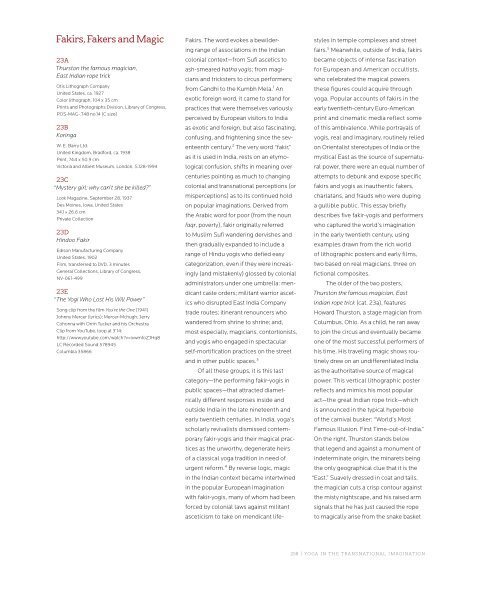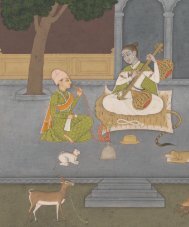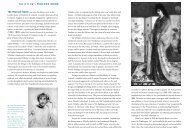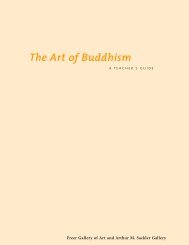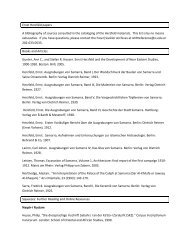228 | YOGA IN THE TRANSNATIONAL IMAGINATION
228 | YOGA IN THE TRANSNATIONAL IMAGINATION
228 | YOGA IN THE TRANSNATIONAL IMAGINATION
Create successful ePaper yourself
Turn your PDF publications into a flip-book with our unique Google optimized e-Paper software.
Fakirs, Fakers and Magic<br />
23A<br />
Thurston the famous magician,<br />
East Indian rope trick<br />
Otis Lithograph Company<br />
United States, ca. 1927<br />
Color lithograph, 104 x 35 cm<br />
Prints and Photographs Division, Library of Congress,<br />
POS-MAG-.T48 no.14 (C size)<br />
23B<br />
Koringa<br />
W. E. Barry Ltd.<br />
United Kingdom, Bradford, ca. 1938<br />
Print, 74.4 x 50.9 cm<br />
Victoria and Albert Museum, London, S.128-1994<br />
23C<br />
“Mystery girl: why can’t she be killed?”<br />
Look Magazine, September 28, 1937<br />
Des Moines, Iowa, United States<br />
34.1 × 26.6 cm<br />
Private Collection<br />
23D<br />
Hindoo Fakir<br />
Edison Manufacturing Company<br />
United States, 1902<br />
Film, transferred to DVD, 3 minutes<br />
General Collections, Library of Congress,<br />
NV-061-499<br />
23E<br />
“The Yogi Who Lost His Will Power”<br />
Song clip from the film You’re the One (1941)<br />
Johnny Mercer (lyrics); Mercer-Mchugh; Jerry<br />
Cohonna with Orrin Tucker and his Orchestra<br />
Clip from YouTube, loop at 3’14:<br />
http://www.youtube.com/watch?v=ixwmfoZJHq8<br />
LC Recorded Sound 578945<br />
Columbia 35866<br />
Fakirs. The word evokes a bewildering<br />
range of associations in the Indian<br />
colonial context—from Sufi ascetics to<br />
ash-smeared hatha yogis; from magicians<br />
and tricksters to circus performers;<br />
from Gandhi to the Kumbh Mela. 1 An<br />
exotic foreign word, it came to stand for<br />
practices that were themselves variously<br />
perceived by European visitors to India<br />
as exotic and foreign, but also fascinating,<br />
confusing, and frightening since the seventeenth<br />
century. 2 The very word “fakir,”<br />
as it is used in India, rests on an etymological<br />
confusion, shifts in meaning over<br />
centuries pointing as much to changing<br />
colonial and transnational perceptions (or<br />
misperceptions) as to its continued hold<br />
on popular imaginations. Derived from<br />
the Arabic word for poor (from the noun<br />
faqr, poverty), fakir originally referred<br />
to Muslim Sufi wandering dervishes and<br />
then gradually expanded to include a<br />
range of Hindu yogis who defied easy<br />
categorization, even if they were increasingly<br />
(and mistakenly) glossed by colonial<br />
administrators under one umbrella: mendicant<br />
caste orders; militant warrior ascetics<br />
who disrupted East India Company<br />
trade routes; itinerant renouncers who<br />
wandered from shrine to shrine; and,<br />
most especially, magicians, contortionists,<br />
and yogis who engaged in spectacular<br />
self-mortification practices on the street<br />
and in other public spaces. 3<br />
Of all these groups, it is this last<br />
category—the performing fakir-yogis in<br />
public spaces—that attracted diametrically<br />
different responses inside and<br />
outside India in the late nineteenth and<br />
early twentieth centuries. In India, yoga’s<br />
scholarly revivalists dismissed contemporary<br />
fakir-yogis and their magical practices<br />
as the unworthy, degenerate heirs<br />
of a classical yoga tradition in need of<br />
urgent reform. 4 By reverse logic, magic<br />
in the Indian context became intertwined<br />
in the popular European imagination<br />
with fakir-yogis, many of whom had been<br />
forced by colonial laws against militant<br />
asceticism to take on mendicant life-<br />
styles in temple complexes and street<br />
fairs. 5 Meanwhile, outside of India, fakirs<br />
became objects of intense fascination<br />
for European and American occultists,<br />
who celebrated the magical powers<br />
these figures could acquire through<br />
yoga. Popular accounts of fakirs in the<br />
early twentieth-century Euro-American<br />
print and cinematic media reflect some<br />
of this ambivalence. While portrayals of<br />
yogis, real and imaginary, routinely relied<br />
on Orientalist stereotypes of India or the<br />
mystical East as the source of supernatural<br />
power, there were an equal number of<br />
attempts to debunk and expose specific<br />
fakirs and yogis as inauthentic fakers,<br />
charlatans, and frauds who were duping<br />
a gullible public. This essay briefly<br />
describes five fakir-yogis and performers<br />
who captured the world’s imagination<br />
in the early twentieth century, using<br />
examples drawn from the rich world<br />
of lithographic posters and early films,<br />
two based on real magicians, three on<br />
fictional composites.<br />
The older of the two posters,<br />
Thurston the famous magician, East<br />
Indian rope trick (cat. 23a), features<br />
Howard Thurston, a stage magician from<br />
Columbus, Ohio. As a child, he ran away<br />
to join the circus and eventually became<br />
one of the most successful performers of<br />
his time. His traveling magic shows routinely<br />
drew on an undifferentiated India<br />
as the authoritative source of magical<br />
power. This vertical lithographic poster<br />
reflects and mimics his most popular<br />
act—the great Indian rope trick—which<br />
is announced in the typical hyperbole<br />
of the carnival busker: “World’s Most<br />
Famous Illusion. First Time-out-of-India.”<br />
On the right, Thurston stands below<br />
that legend and against a monument of<br />
indeterminate origin, the minarets being<br />
the only geographical clue that it is the<br />
“East.” Suavely dressed in coat and tails,<br />
the magician cuts a crisp contour against<br />
the misty nightscape, and his raised arm<br />
signals that he has just caused the rope<br />
to magically arise from the snake basket<br />
258 | <strong>YOGA</strong> <strong>IN</strong> <strong>THE</strong> <strong>TRANSNATIONAL</strong> IMAG<strong>IN</strong>ATION


